How to Successfully Create an Effective Team of Remote Workers
Did you know that the number of people who work remotely has increased by 140% since 2005?
Remote work has indeed become a big trend in several industries and with many proven benefits in terms of productivity, work-life balance, and overall wellbeing, it’s not difficult to understand why.
If you’re thinking about creating a remote team in your company but don’t know where to start, we have all the tips you need. Read on!

1. Hire the Right Remote Workers
Working remotely is quite different from working in-house and it might not be for everyone.
Before you speak with any potential hire, consider which qualities you’re looking for in this new team member and then tweak your interview process accordingly.
A few things you can’t forget are:
- The remote employee won’t have a team leader around to make sure they’re working. They need to be motivated.
- They might choose to work remotely because they have other responsibilities to attend to, like a child or housework. They need to be organized and able to multitask.
- They won’t be at the office to solve any potential issues in person. They need to have good communication skills.
A remote worker can always improve their working habits as they gain more experience, so be flexible. Having said that, try to have a good idea of the candidates’ motivation before closing any deals.
2. Create a Quality Onboarding Process
Your remote team is just as valuable as your in-house team and you need to treat them as such, starting from the get-go.
Of course, your traditional onboarding process won’t do for remote employees. Just like you did with your interviewing method, you’ll need to tweak this process as well.
A few details you can do that will make your new team member feel welcome and well-oriented would be:
- Scheduling a video call where you can give them all the relevant information and they can ask you any questions they might have. Not only is this an easier and faster way to introduce them to the company but it’s also a more personal way of connecting than exchanging emails.
- Setting expectations for their work. Although one perk of remote working is freedom, you’re still hiring this new team member for a reason. Don’t forget to establish goals and deadlines from day one.
- Sending the onboarding documents just like you do for your in-house hires. This way they can always revisit it in case of any doubt.
Pro tip: Create an onboarding document that’s tailored towards remote workers. Besides the usual information like company values and history, be clear about the remote working culture in your company.
3. Communicate, Communicate, Communicate

Communication is key when it comes to managing a remote team but, as you can imagine, it requires a bit more effort from your part.
So, how can you make sure you connect with your remote team and maintain personal connections with them?
Organizing regular video calls is extremely helpful. If you only communicate with your remote employees via email, you risk creating a relationship that feels mechanical. However, if you actually see each other’s faces and body language, it becomes a lot easier to create meaningful connections.
Another good idea is having a way of talking quickly and at any time of the day. Many teams use Slack, a collaboration tool that allows you to create chat conversations and speak regularly in a much easier way.
Pro tip: Use your video calls with remote workers to ask for feedback. This way you can continuously improve your management style and make sure everyone is productive, no matter where they are.
4. Use the Right Management Tools
Organization is essential for managing a productive remote team. But how can you ensure that when you have employees spread all over the country - or even the world?
Simple: by using tools where you can gather all the relevant information you need to keep an eye on as a team leader.
Breeze allows you to do just that. With our tool, you can consult and update your projects’ timeline, detail all future tasks (and assign them to the right employee), track the workload and time management of each remote worker, and much more.
By having all of this data on one single workspace, you can rest assured that you’re always on top of your remote team’s work.
5. Find Ways to Meet Your Remote Workers in Person
Last but not least and because it’s not all about work, try to organize get-togethers that include your remote employees.
Whether it is an annual kick-off day, a regular team-building event or even just a casual happy hour, making it easy for your remote employees to actually hang out with their coworkers will make them feel included at a whole new level.
Pro tip: With an international team, it becomes harder to organize meetups - but harder doesn’t mean impossible. If you have the budget for it, why not create a bigger event - perhaps a conference or a trip - that will make it worth it for your remote employees to catch a flight in order to meet you?
Ready to try Breeze and create your awesome remote team? Start your free trial today!








